This latest collection of mushroom drawings is by popular request. Even though I already have a few colourful mushroom illustrations on the site, people were looking for some black and white ones.
I have a friend, a textile print designer looking for mushroom illustrations to use as a reference for a fabric design.
Like many people, I like mushrooms, fungi and toadstools prints. They are a popular theme in interiors at the moment. I have some James Sowerby mushroom prints framed on my walls. Mushroom crafts are also trendy.
I have even printed some of these fungi prints on to fabric to create a fun 3D mushroom display.
Mushrooms, fungi or toadstools?
Mushrooms are the fruit of fungi. They are the structure that produces the “seeds” known as microscopic spores for the reproduction of the fungi.
Toadstools are another name for mushrooms, but the label tends to be associated with the more colourful poisonous mushrooms. They often refer to the red mushrooms with white spots that are popular in fairytales.
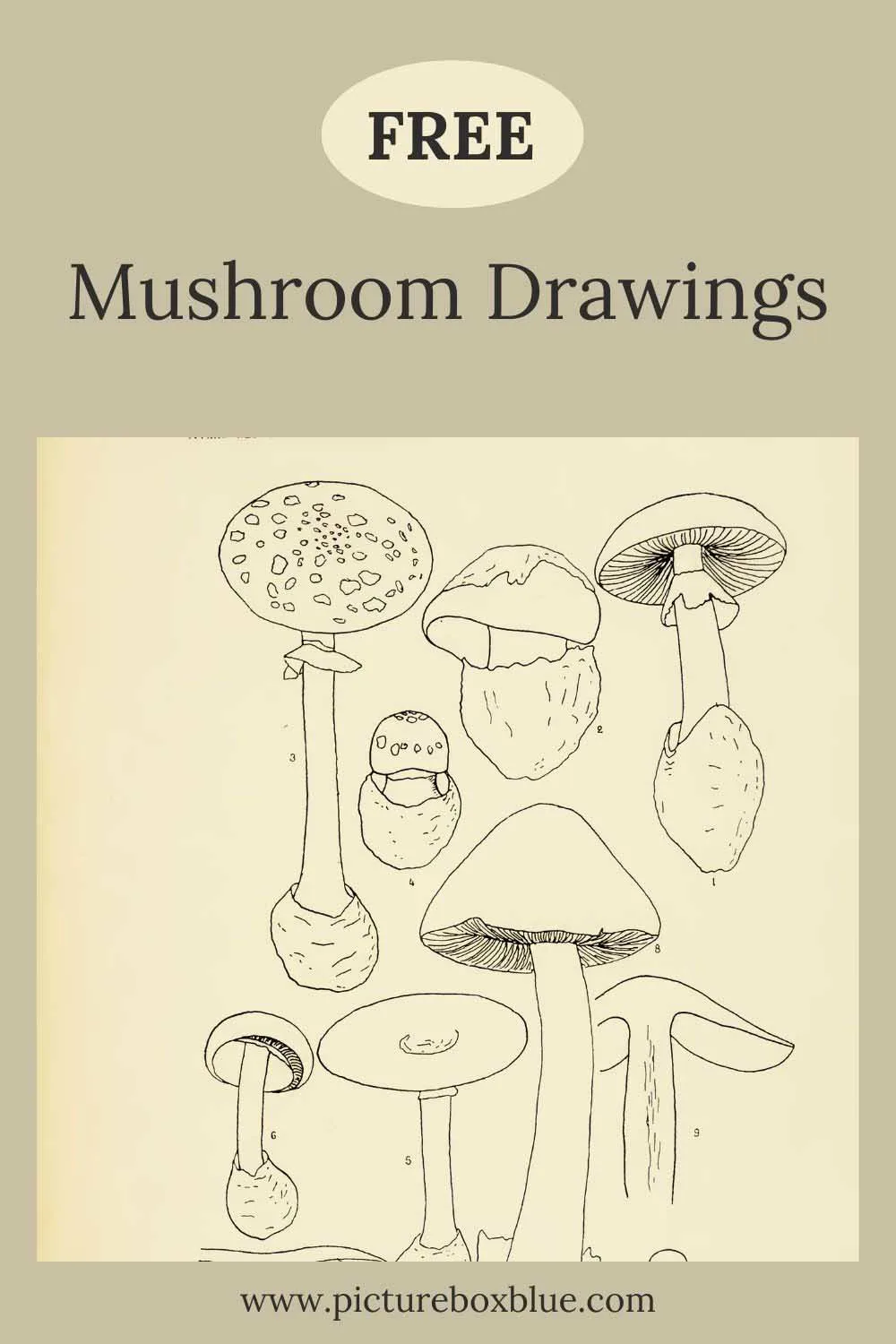
The Mushroom Drawings
All the mushrooms below are in black and white. They are a great source of art reference for those who like to draw and paint mushrooms and would also be great for colouring pages. Or maybe you want simple black and white drawings for decoration.
To download the drawings you want, click on the title above them. A high-resolution image will open in a new window on your browser. Click on that picture to save or print it for free.
All the mushroom drawings are in the Public Domain and thus copyright free, which means you can use them as you like.
Atlas Des Champignons – Drawings
The first four sets of mushroom drawings are from the book “Atlas des champignons parasites et pathogènes de l’homme et des animaux“. This translates as “Atlas of parasitic and pathogenic fungi of man and animals.” Henri Coupin 1900.
Henri Coupin (1868-1937) was a prolific French author and botanist who wrote over 200 books.
1. Poisonous Mushrooms 1
These simple mushroom line drawings are a great reference source for illustrators, artists and crafters.
The mushroom identified as number 1 is known as a death cap (Amanita phalloides). One of the most toxic mushrooms. It sneakily looks similar to many edible species, resulting in accidental poisonings. Its toxicity isn’t reduced by cooking, which adds to the danger of this mushroom. Half a mushroom is enough to kill an adult. It’s thought death cap mushrooms were involved in the death of two Roman emperors, including Claudius AD54.
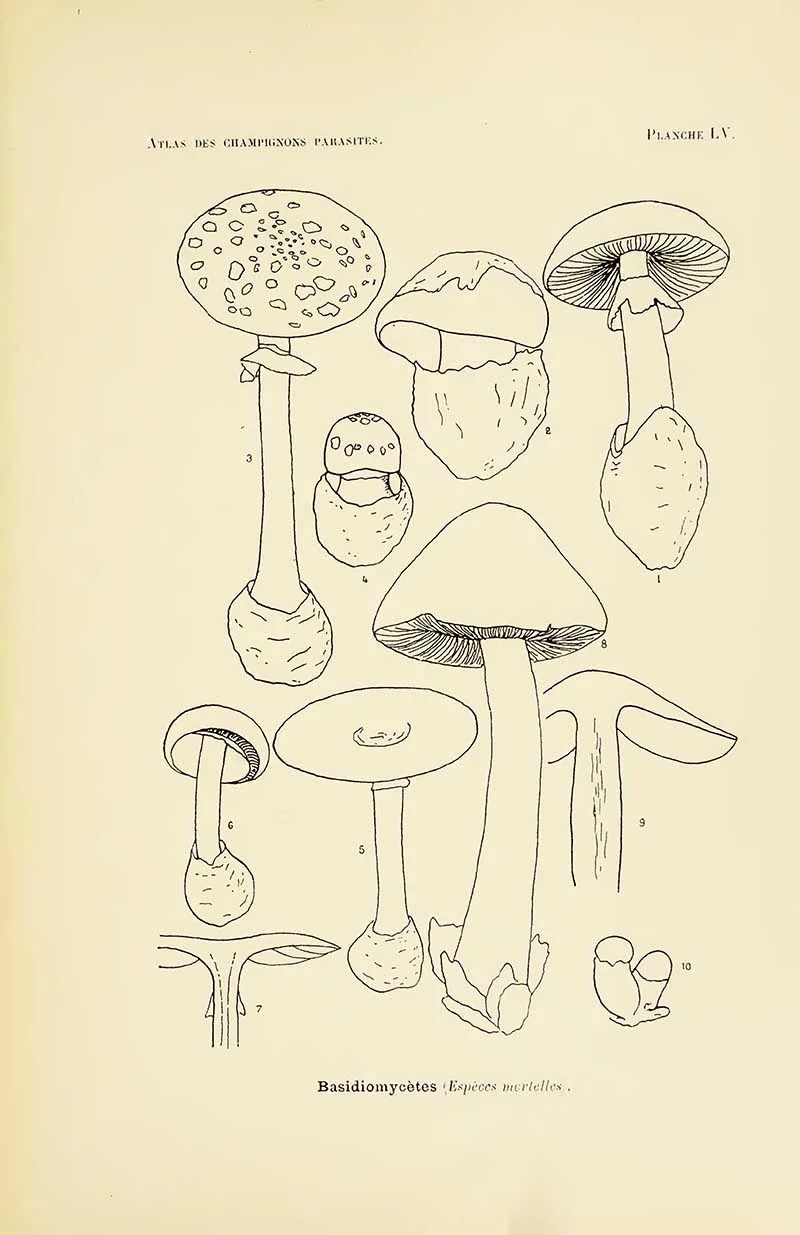
2. Poisonous Mushrooms 2
Coupin describes the next set of mushrooms as poisonous, dangerous or at least suspects.
The mushroom drawing labelled number 1 in this collection is known as the fly agaric (Amanita muscaria). It’s probably the mushroom that is more like the iconic toadstool associated with popular culture. It is a red mushroom with large white gilled and white spots. It’s the toadstool you’ll see in the Super Mario games and as the houses in the Smurf comics.
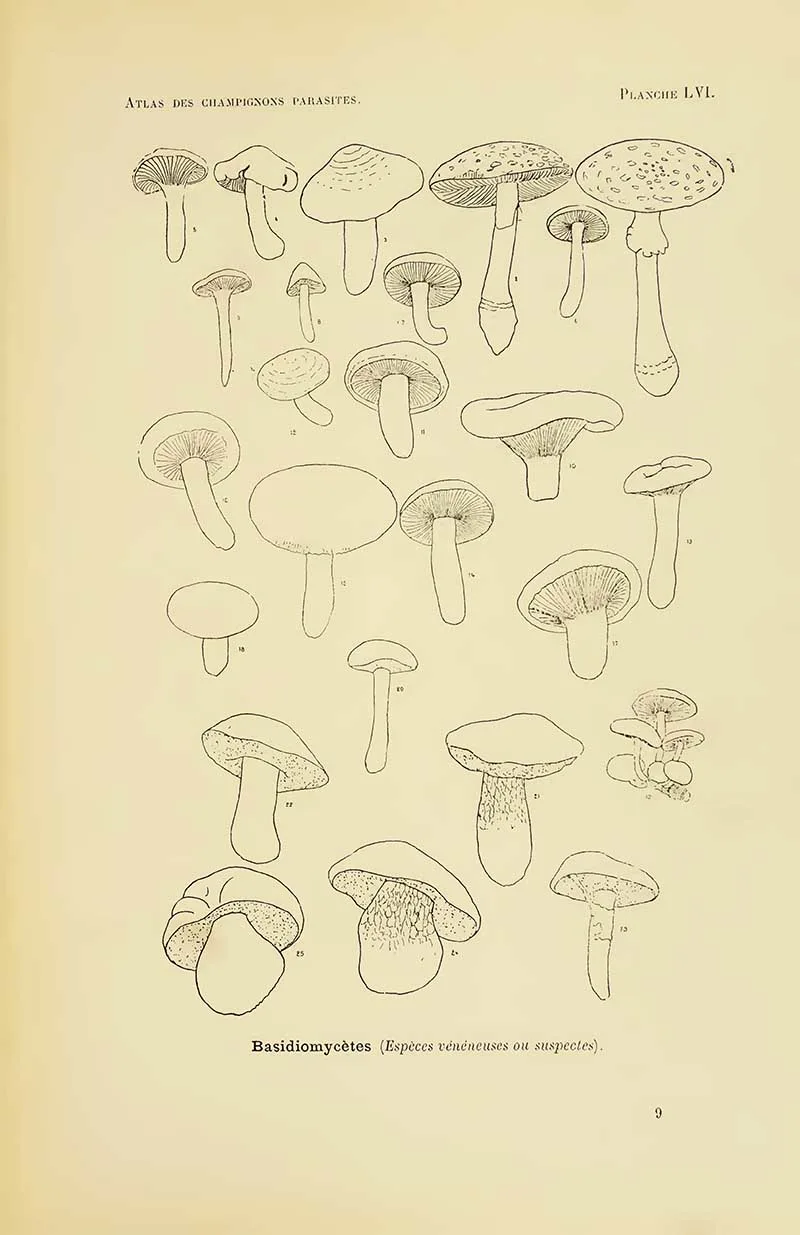
3. Poisonous Mushroom Drawings 3
Pen drawings mixture of poisonous oyster and cap mushrooms.
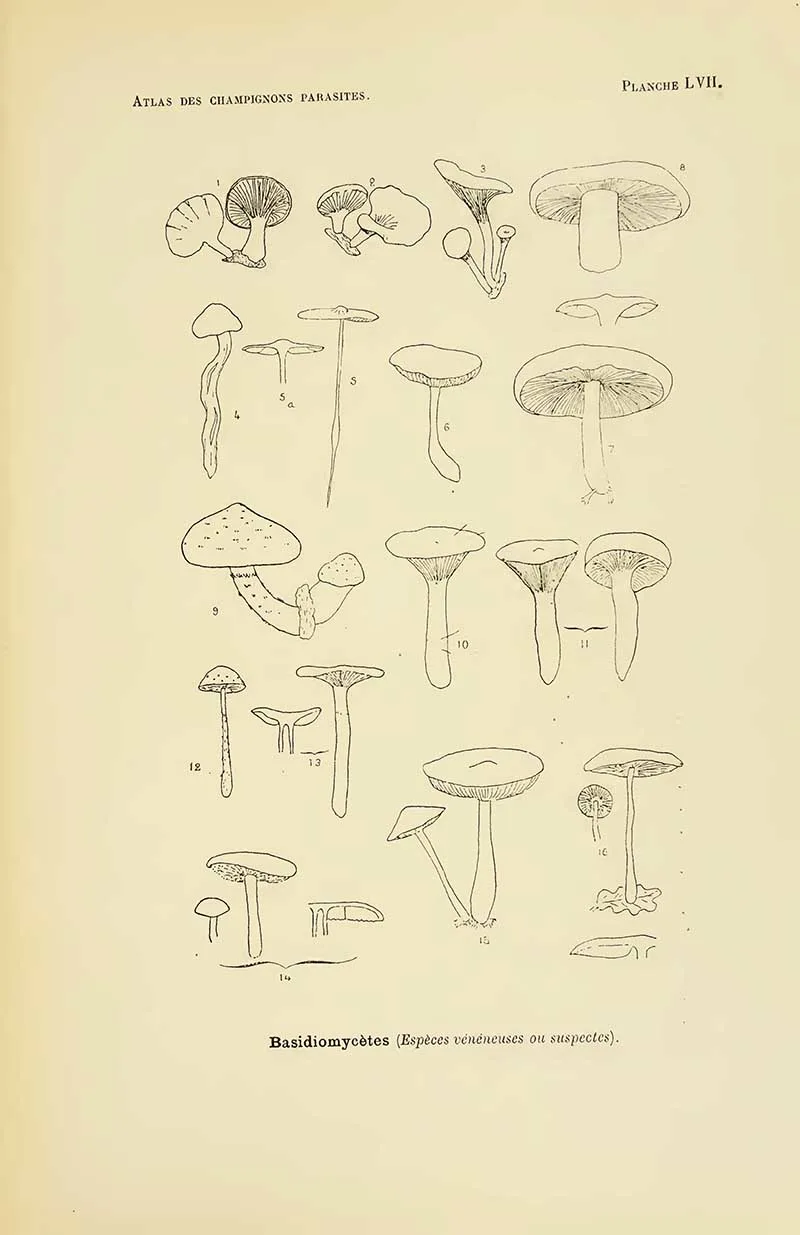
4. Poisonous Mushrooms Coupin 4
The mushroom marked 5 in this collection is the Lactarius blennius, more commonly known as a slimy milkcap. Probably one of the fungi Coupin classified as “dangerous or suspect“, there is debate about its toxicity.
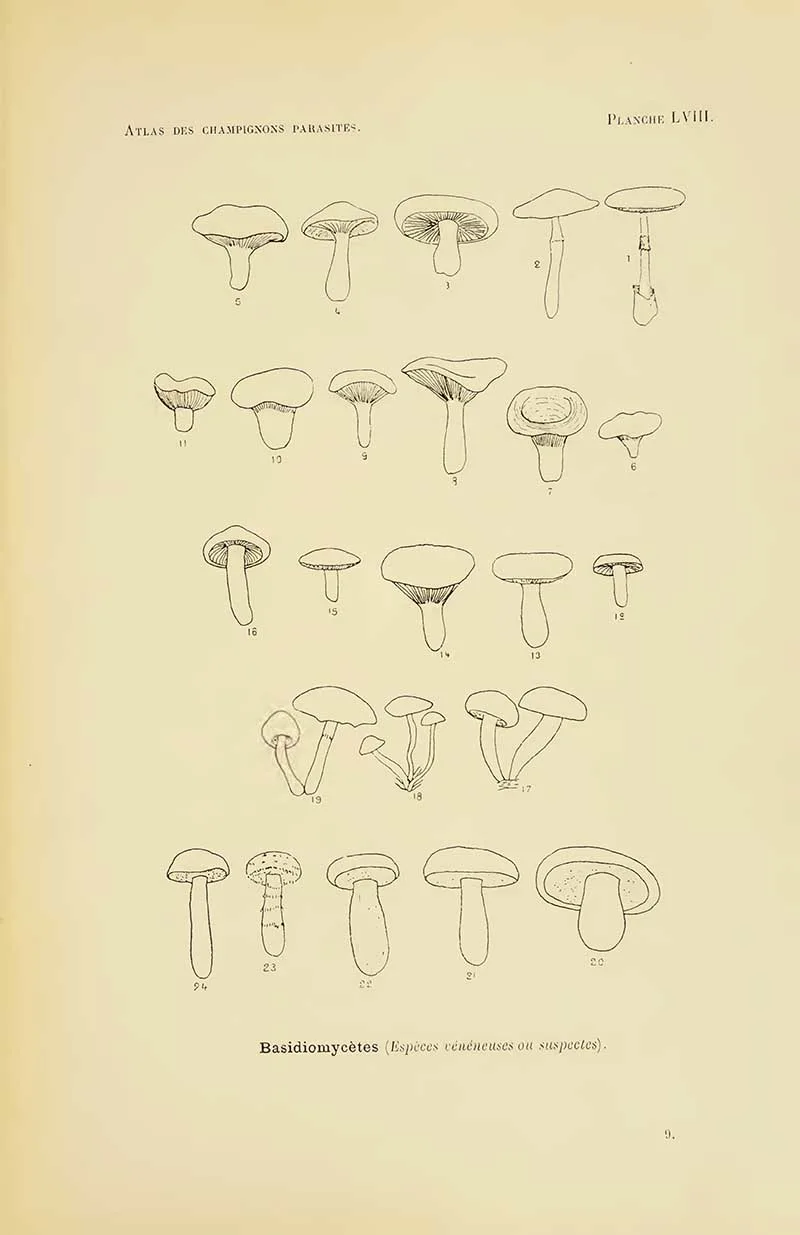
American Student Handbook
The next set of mushroom drawings is from “Student’s hand-book of mushrooms of America edible and poisonous” 1897, by Taylor, Thomas.
5. Common Field Mushroom
A sketch of the common field mushroom, Agaricus campester.
- Fig. 1 represents the mature plant
- Fig. 2, a sectional view of the same
- Fig. 3, the basidia, club-shaped cells from the summit of which proceed the slender tubes called sterigmata, which support the spores — highly magnified
- Fig. 4, the sterigmata
- Fig. 5, the mycelium, highly magnified, supporting immature mushrooms
- Fig. 6, the spores as shed from an inverted mushroom cap
- Fig. 7, spores magnified.
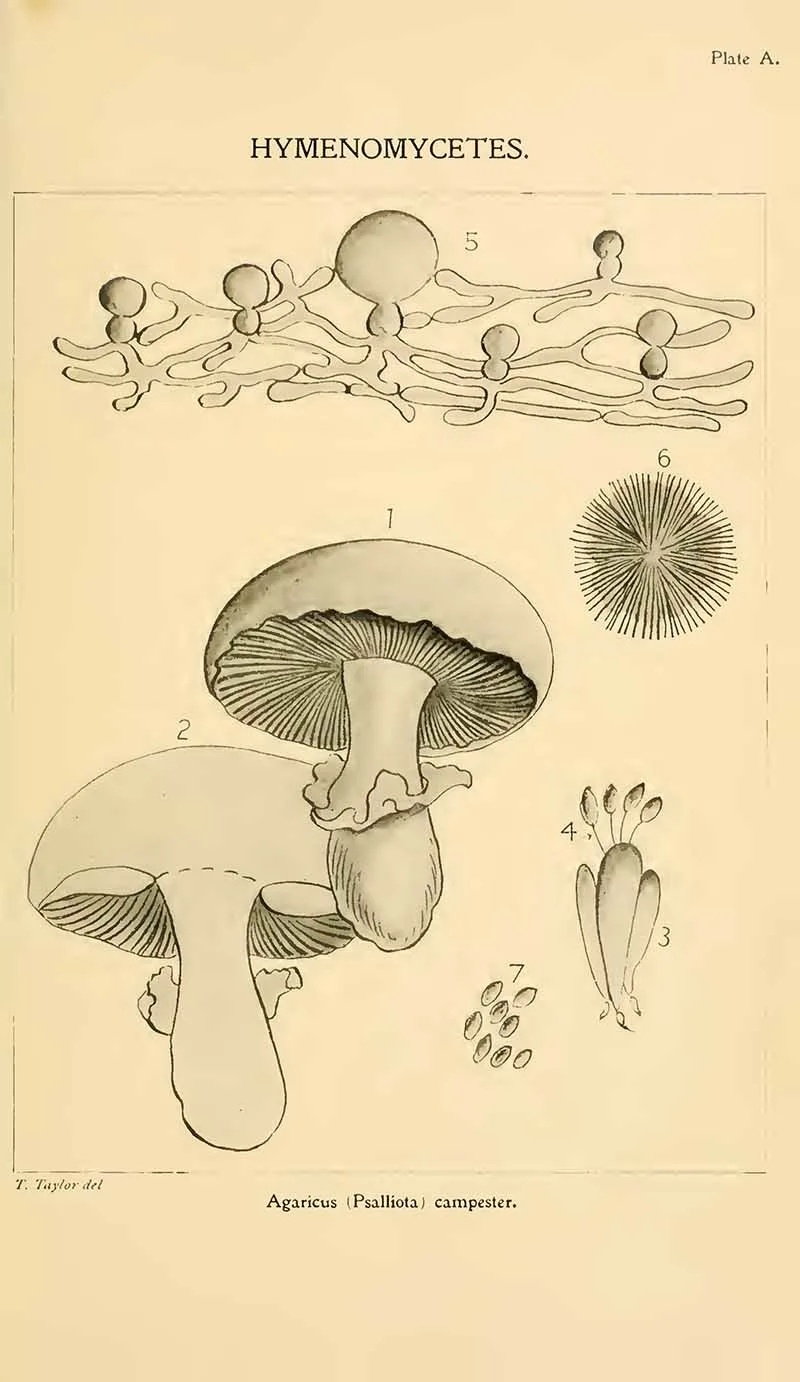
6. Hymenomycetes
The leading type of each of the six orders of the family Hymenomycetes:
Fig. 1. Cap with radiating gills beneath. Agaricini.
Fig. 2. Cap with spines or teeth beneath. Hydnei.
Fig. 3. Cap with pores or tubes beneath. Polyporei.
Fig. 4. Cap with the under or spore-bearing surface even. Thelephorei.
Fig. 5. The whole plant is club-shaped, bush-like and branched. Clavarei.
Fig. 6. Whole plant irregularly expanded, substance gelatinous. Tremellini.
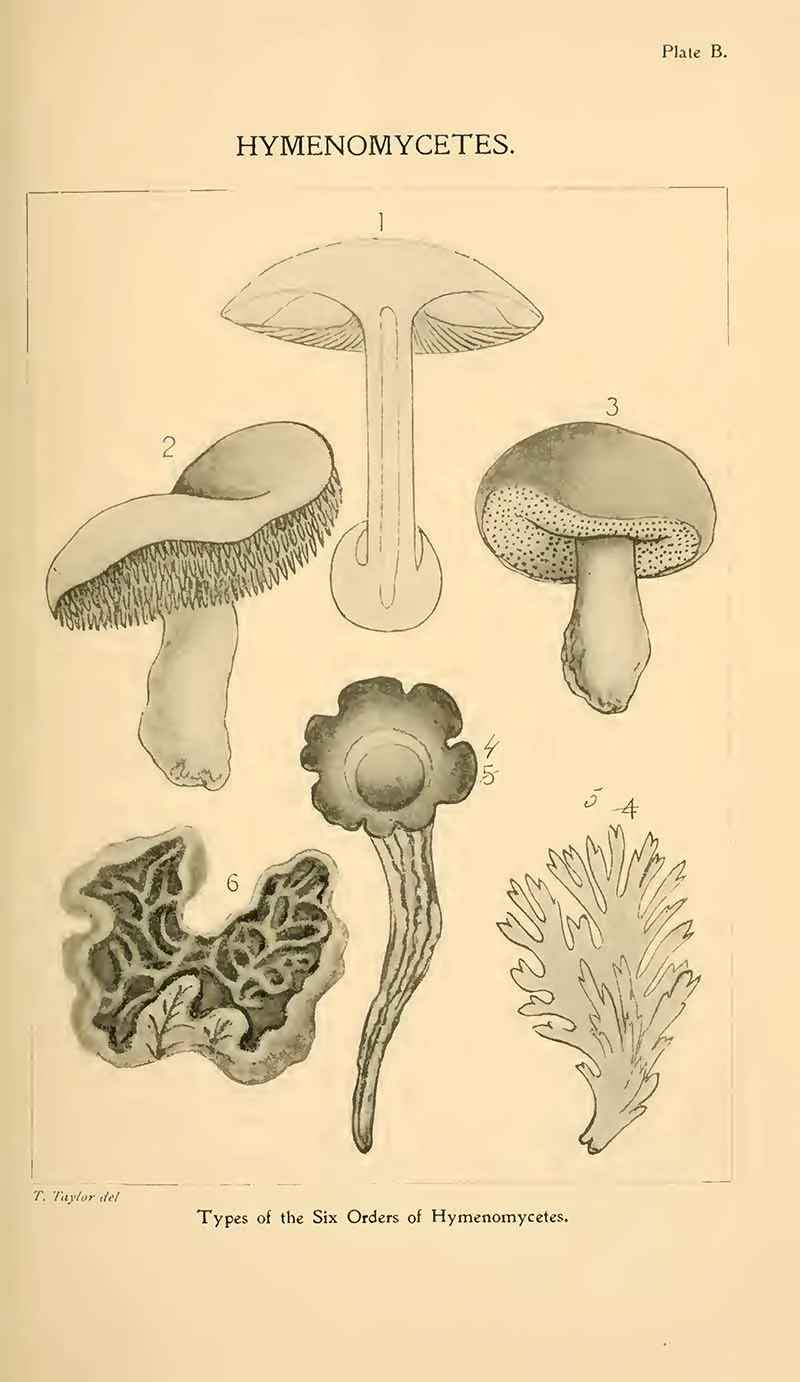
7. Ascomycetes
Ascomycetes are ‘spore shooters’. They are fungi which produce microscopic spores inside special, elongated cells or sacs, known as ‘asci’, which give the group its name.
These fungi have many uses from the formation of antibiotics, fermentation of bread, cheese and alcohol.
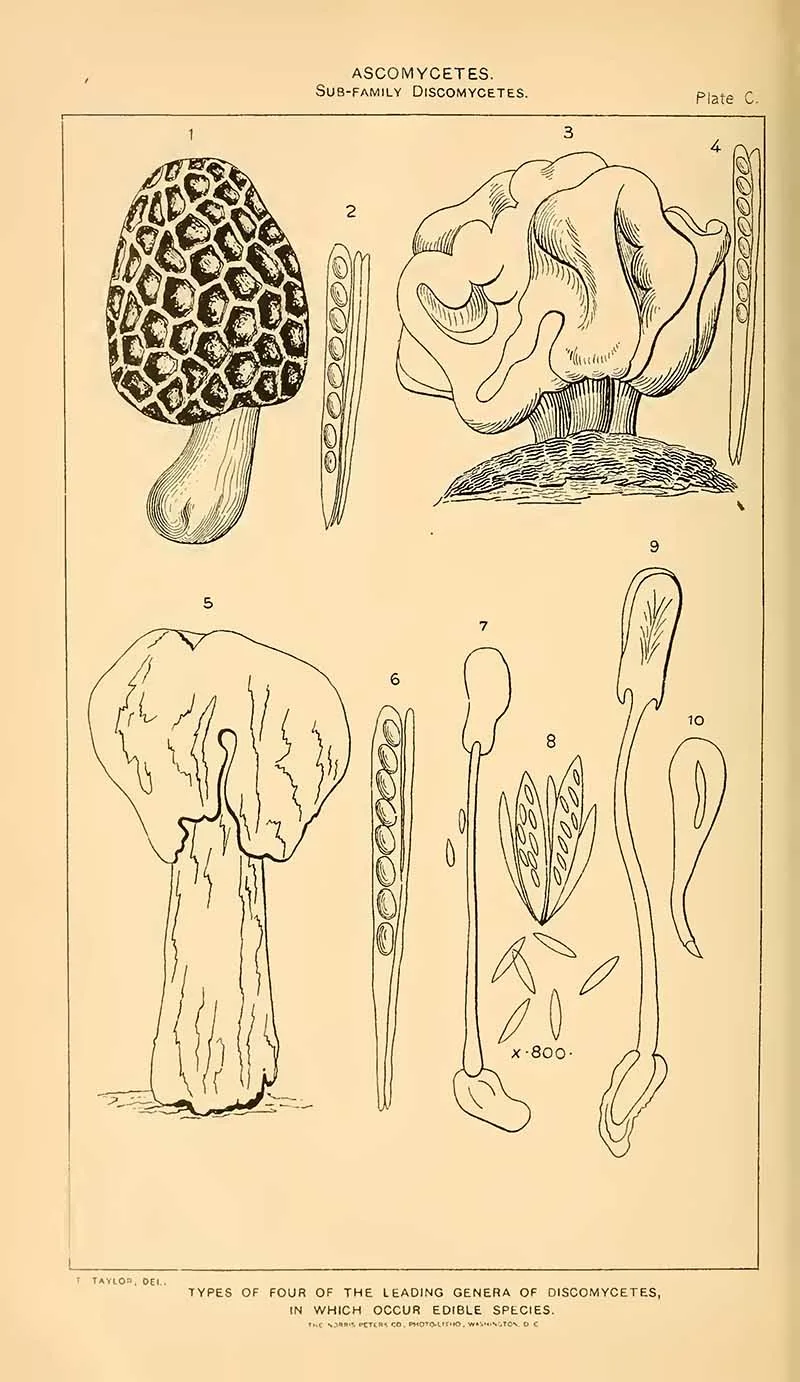
8. Morchella
Morchella semilibera, commonly called the half-free morel, this is an edible mushroom.
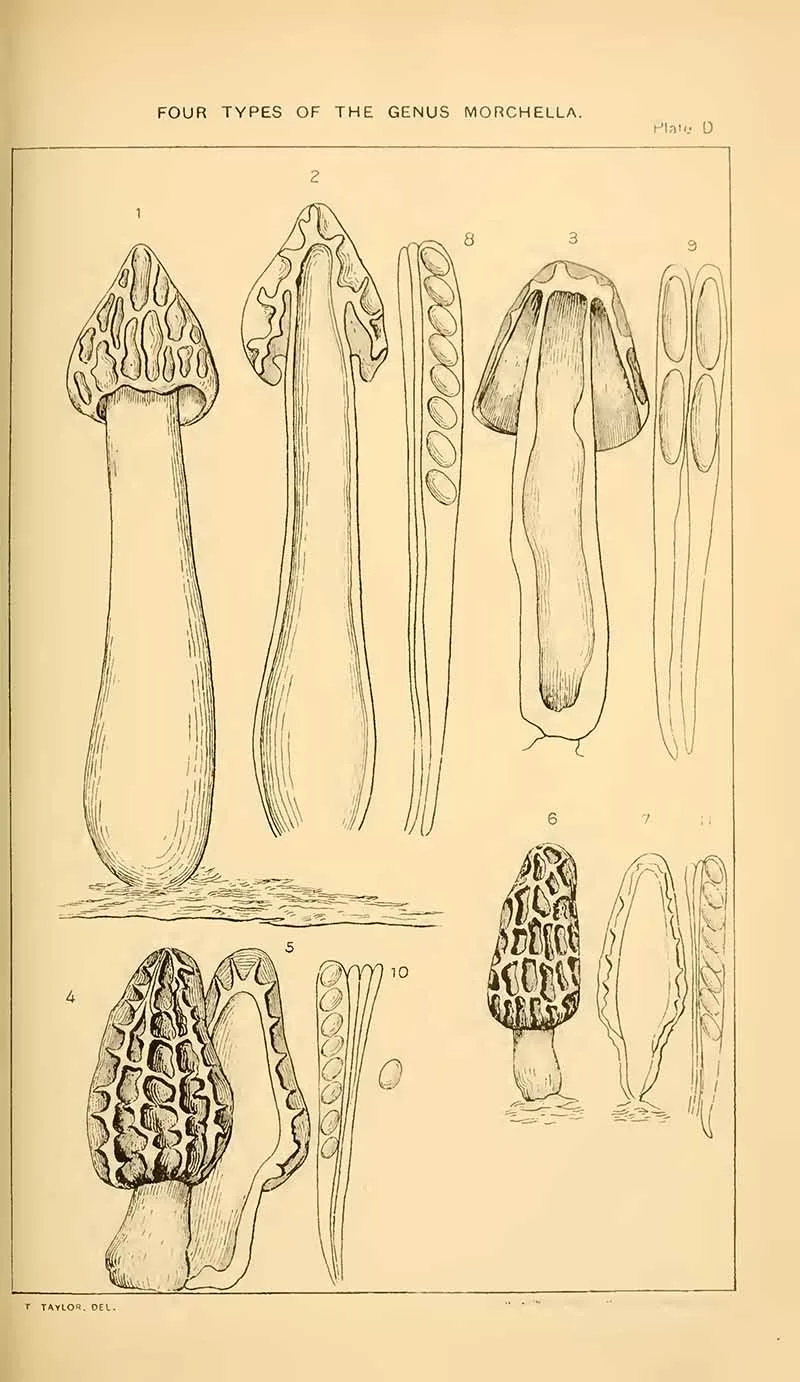
9. Ring Characteristics of Mushrooms
Drawings of various forms and positions of the annulus or ring-characteristics of mushrooms.
Fig. 1. Ring broad, reflexed or deflexed, or both; situated high up on the stem, as in Armillaria niellea.
Eig. 2. Ring situated about midway of the stem, deflexed and pendulous as in Amanita muscaria.
Fig. 3. Ring about half midway of the stem, split, and radiating outwards, as in Agaricus arvensis.
Fig. 4. Ring drooping.
Fig. 5. Ring persistent, movable, wholly detached, in age, from the tall and slender stem, upon which it easily slips up and down. A species of great beauty, Lfinota procera.
Fig. 6. Ring narrow, scarcely perceptible above the middle of the stem; remnants of the veil adhering to the margin of the cap as a fugacious web.
Fig. 7. Ring generally wanting -Tricholoma nudum. Remnants of the veil are seen on the margin of the cap.
Fig. 8. Remnants of the veil appear on the margin of the cap as a fringe, and particularly on the stem as a mere fibrillose zone of darker colour as in the Cortinarii.
Fig. 9. Plant exhibiting the cortina unbroken, the extremities of its delicate arachnoid threads attached to cap and stem, respectively.
Fig. 10. Section of a Russula, in which genus the ring is always wanting; veil none.
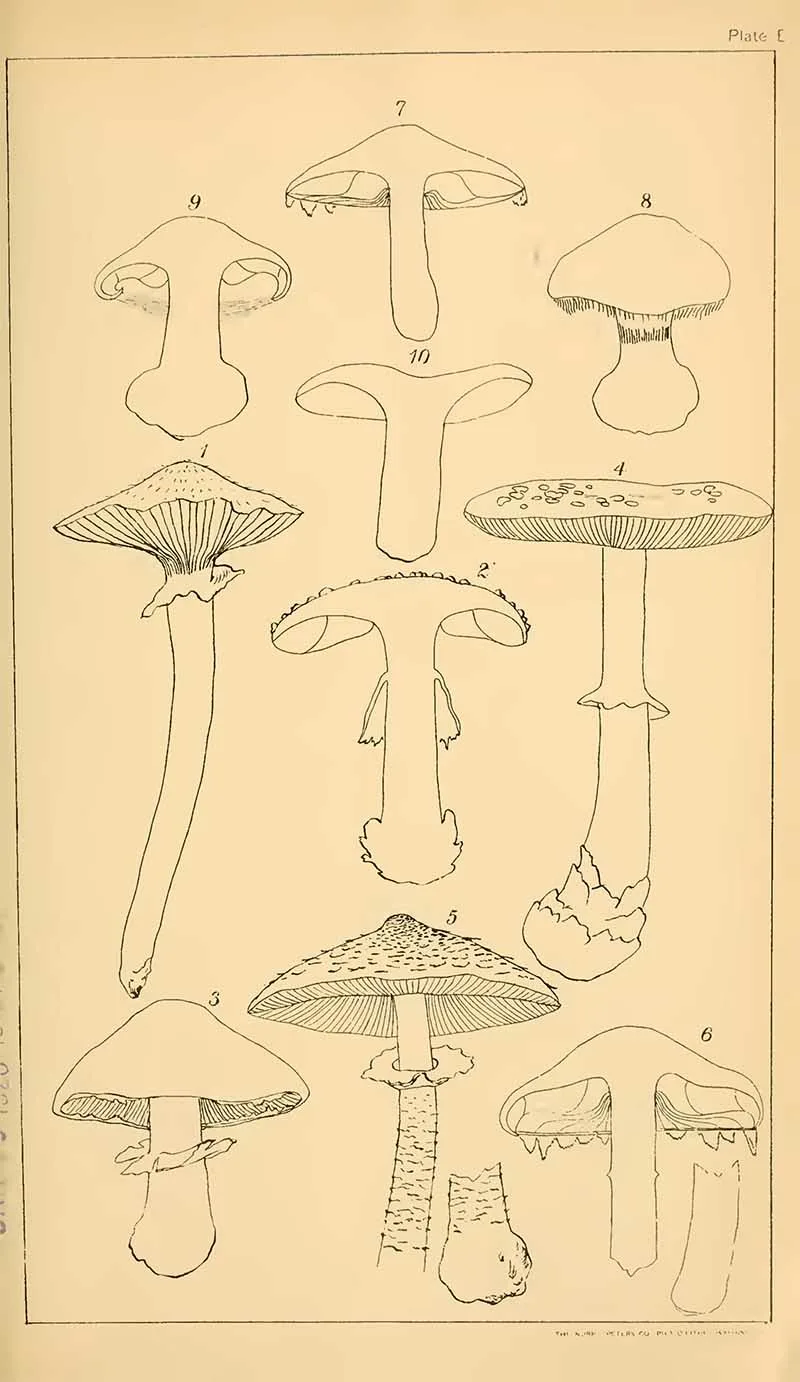
10. Fir Cone Mushroom
This mushroom is very pleasant to the taste when raw as well as when cooked. It is found in light woods or on the borders of woods where the soil is somewhat friable, generally solitary, but sometimes two or three are found clustered together.
The plants are sometimes so large that two or three of them would make a very good meal. Specimens have been found with the cap measuring 8 to 9 inches across when expanded, the stem varying from 6 to 8 inches in height, and from 1 to 3 inches in thickness.
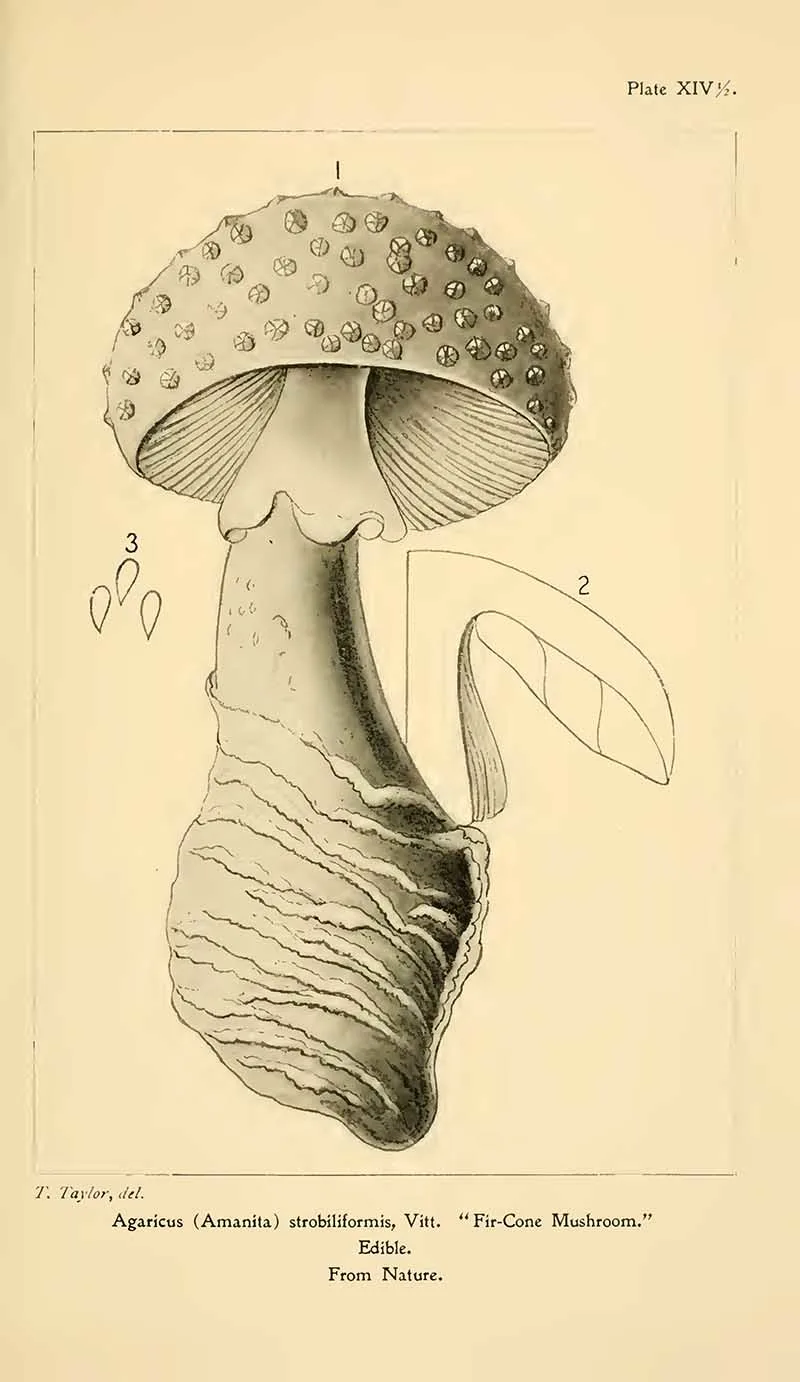
British fungus-flora Drawings
The next set of black and white fungi drawings are from the book “British fungus-flora. A classified text-book of mycology”, George Massee, 1892.
11. British Mushroom Drawings 1
The mushroom drawings are as follows:
- Fig. 1, Russula orcholeuca, section through the thickness of a gill, showing the vesicular trama consisting of large spherical cells.
- Fig. 2, & Fig 3 Russula lutea, a small specimen; nat. size
- Fig. 4 & Fig. 5 Amanita mappa; about half nat. size;
- Fig. 6, & Fig. 7 Lepiota crestata; nat. size
- Fig. 8, & Fig. Arimiliaria ramentacea; half nat. size;
- Fig. 10, Fig 11 & Fig. 12. Tricholoma rutilans, half nat. size;
- Fig. 13, & Fig. 14 Mijcena leucogala; half nat. size;
- Fig. 15, & Fig. 16 Collybia hutyracea; about one-third nat. size;
- Fig. 17, Collybia ramealis; nat. size
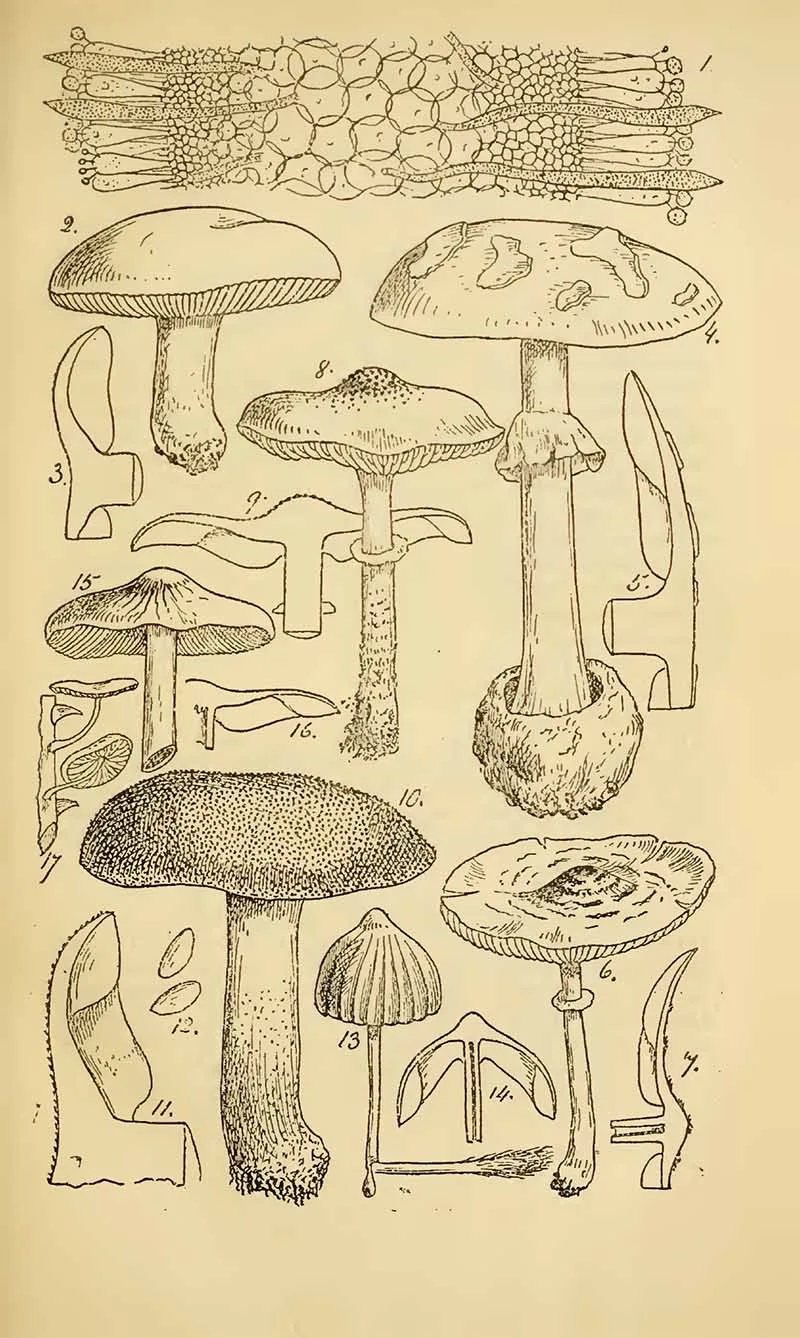
12. British Fungi & Flora 2
Ochrosporae – means brown spored mushrooms.
- Figs. 1, 2 & 3 Crepidotus calolepis, upper surface; nat. size;
- Fig. 4 r section of Tubaria furfuracea, nat. size,
- Fig. 5 & 6, Galera tenera ; nat. tize of a small specimen;
- Fig. 7, Pluteolus reiiculatus ; section ; nat. size of a small specimen;
- Fig. 8 & ( Naucoria temulenta, one-third nat. size ;
- Fig. 10, Pholiota mutabilis, nat. size;
- Fig. 11 & 12, Inocybe scaber; one-third nat. size;
- Fig. 13, spores of eame, X 400;
- Fig. 14, spores of Inocybe asterospora, X 300;
- Fig. 15, Flammula purpurata, half nat. size;
- Fig. 16, Hebeloma glutinosus; section half nat. size;
- Fig. 18, Bolbitius apicalig; half nat. size;
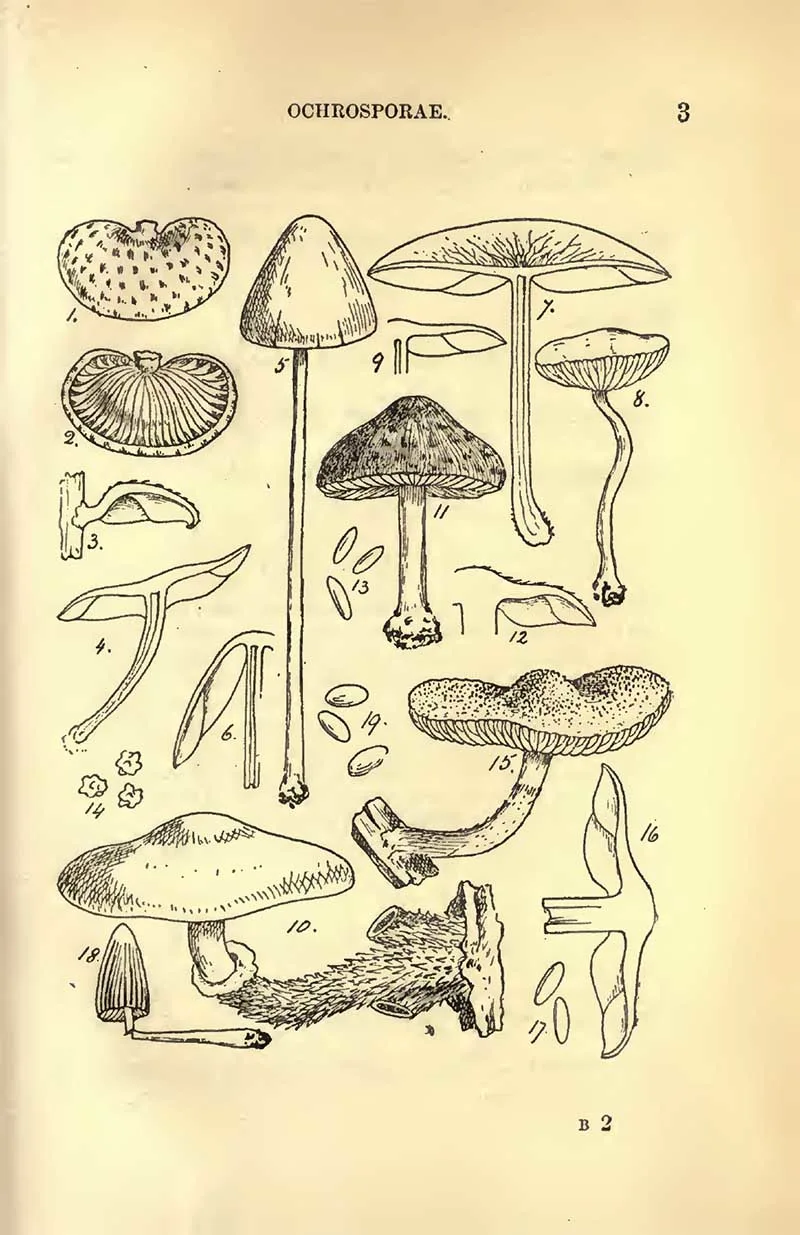
13. British Fungi & Flora 3
- Fig. 1, 2& 3, Morchella esculenta – common morel, one of the most recognisable edible mushrooms.
- Fig. 4 – 8, Rhizina undulata – doughnut fungus
- Fig. 8 -10, Geoglossum glutinosum
- Fig. 11 -12, Leptoglossum microsporum
- Fig. 13, Geoylossum viscosum
- Fig. 14 -15, Gyromitra esculenta – potentially fatal if eaten raw.
- Fig. 16, Gyromitra gigas –giants false morel, the fungus has been banned from sale in France since 1991 due to potential toxicity.
- Fig. 17-18, Helvella crispa – white saddle
- Fig. 19 -21, Verpa digitaliformis
- Fig. 22 -24, Spathularia flavida – yellow fan
- Fig. 25 -28, Leotia lubrica – Jelly baby, edible but not tasty!
- Fig. 29 -30, Mitrula paludosa – swamp beacon, inedible.
- Fig. 31, Morchella ronica
- Fig. 32 -35, Yibrissea truncorum
- Fig. 36, Peziza ochracca
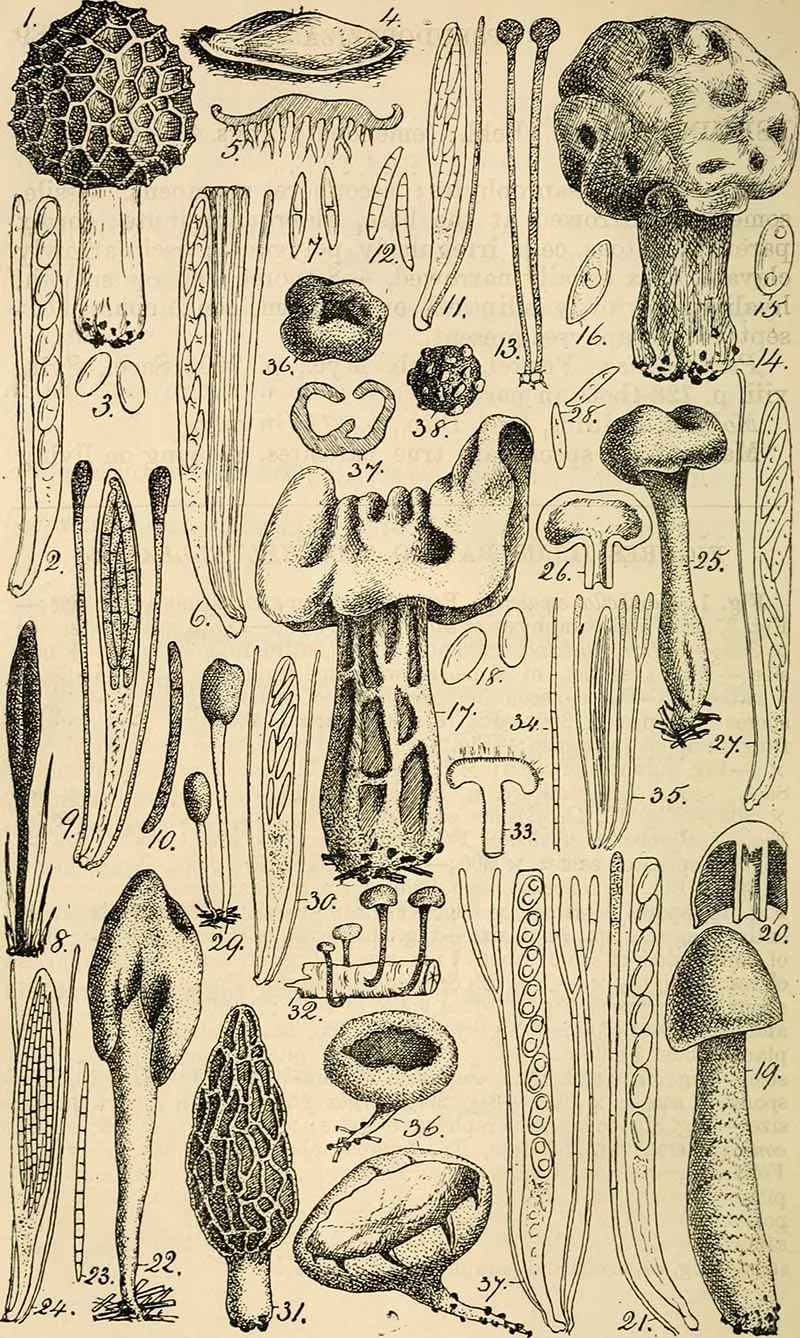
Artistic Mushroom Drawings
14. The Toadstool Family
A pencil on paper drawing, by Sister Maurice Schnell, member of the Sisters of Providence of Saint Mary-of-the-Woods, 1875.
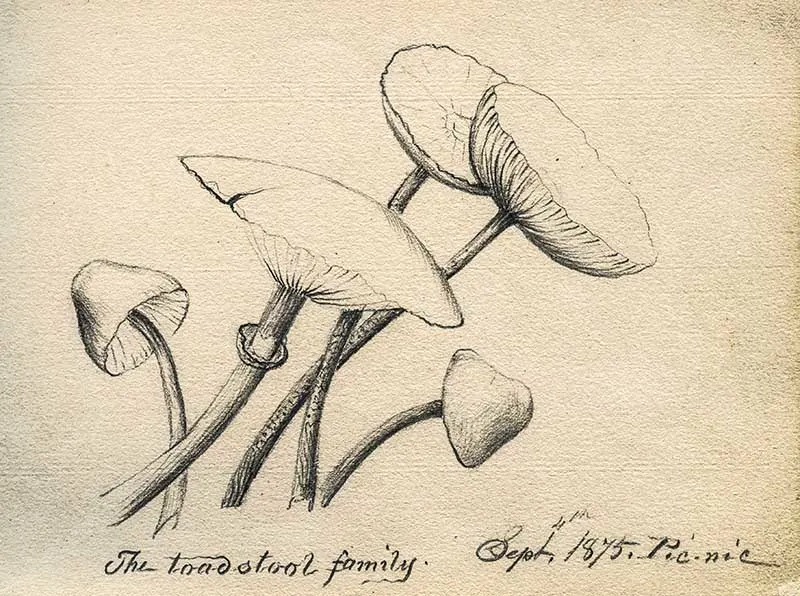
15. Theo van Hoytema – Mushrooms
Theo van Hoytema (1863 -1917) was a Dutch illustrator and graphic designer.
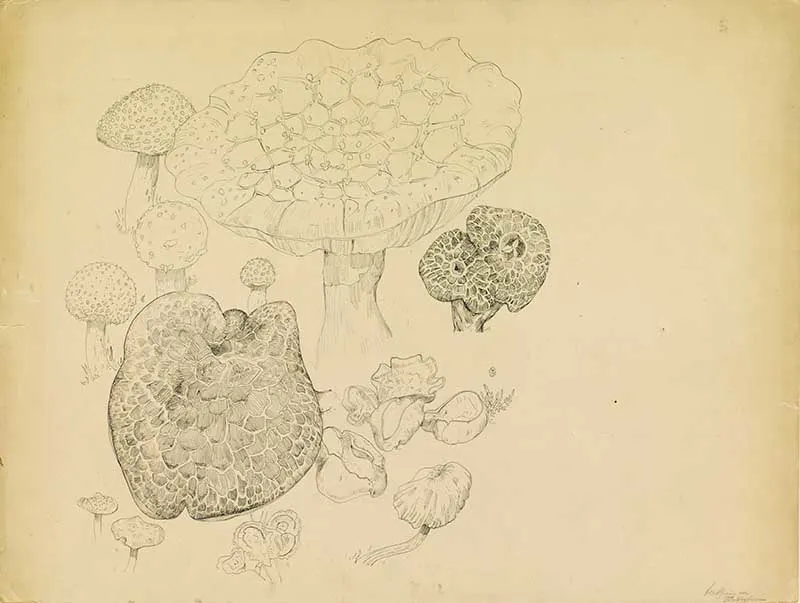
16. Knapp Mushrooms
Drawing of the mushroom Agaricus surrectus, currently known as Volvariella surrecta, commonly known as the piggyback rosegill. Pen illusrationf by Knapp, John Leonard (1829). “The Journal of a Naturalist”.
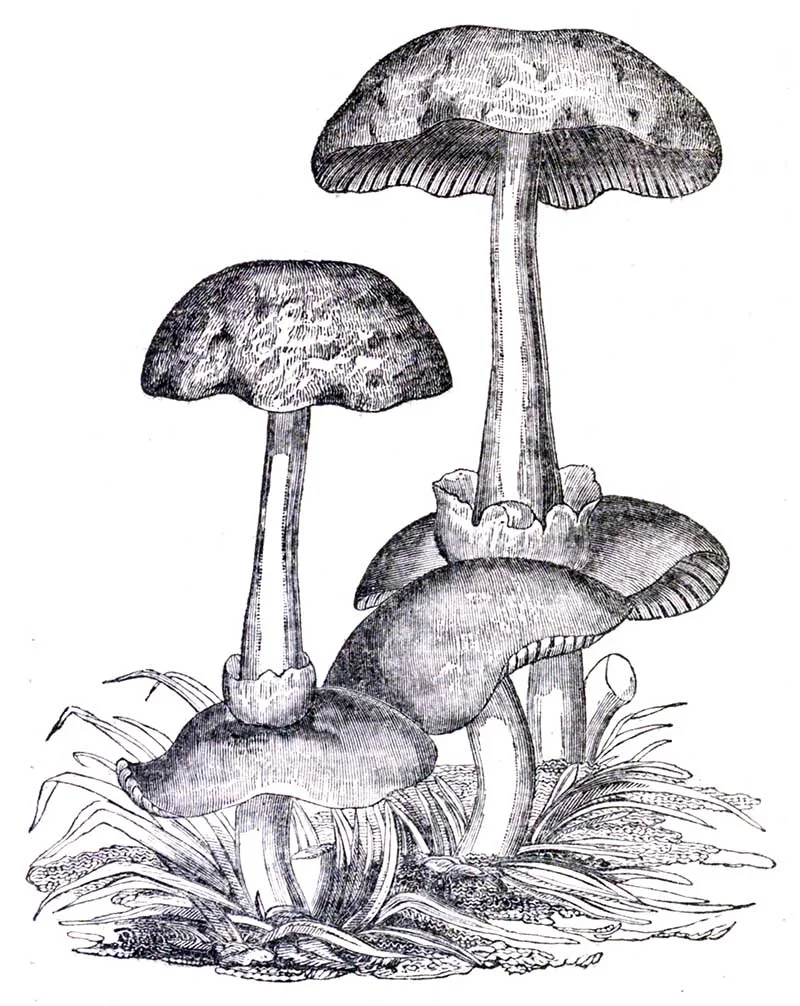
I recommend you check out the three amazing Adolphe Millot mushroom posters on this site. The prints are one of my most popular downloads.
There are many other drawings and illustrations of plants and flowers to check out in the botanical collections. Or even beautiful British seaweed prints.
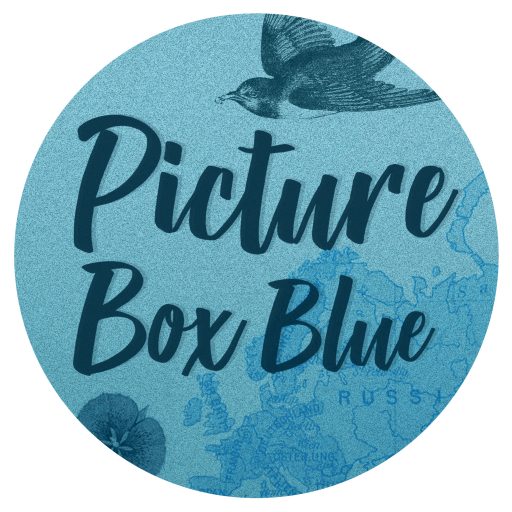
Lee-ann
Thursday 7th of July 2022
Thank you as always, Claire. Some prints are really useful as templates for fairy houses and scenery I want to create for art journalling.
claire
Monday 11th of July 2022
Thank you, your fairy houses sound lovely. I will be publishing some more beautiful botanicals soon which I'm sure you will love too.